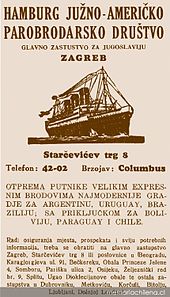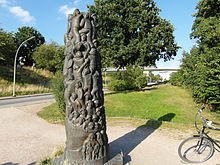Croats
![]()
This article is about the ethnic group of Croats, for other meanings see Croats (disambiguation).
The Croats (Serbo-Croatian Hrvati, Sg. Hrvat) are a South Slavic ethnic group. They are the titular nation of Croatia, where they form the majority of the population with 90.4% (2011), and are defined as the people of Croatia in the Croatian constitutional preamble of 1990.
In Bosnia and Herzegovina they are one of the three "constituent peoples" and in the Serbian autonomous province of Vojvodina they are a recognised autochthonous minority.
Due to the emigration that took place over centuries, numerous people of Croatian descent live in Western Europe, North America, South America and Oceania. Of these, many refer to themselves as Croats in the diaspora, regardless of their nationality.
The majority of Croats are Roman Catholics. They speak predominantly the Croatian language, an umbrella language based on the western variant of the Neoštokavian dialect, which had more correspondence with the Serbian language based on the eastern variant of the Neoštokavian dialect than any other Croatian dialect, and thus was a standard Serbo-Croatian variety in the West-South Slavic branch of the Slavic languages. Speakers of Croatian can effortlessly communicate with speakers of Serbian and Bosnian.
History
Ethnogenesis
The ethnogenesis of the Croats has not yet been conclusively clarified scientifically. There is only evidence that Slavs and Avars settled in the area of present-day Croatia in the 6th/7th century. Before that, Greeks, Illyrians and Romans, among others, lived in the area of today's Croatia.
In the 7th century AD, the territory of present-day Croatia probably belonged to the periphery of the Avar Empire.
In his written records (called "De administrando imperio" by humanists) Constantine VII Porphyrogennetos reports that a nation of Croats was called into the country in the 7th century by the Byzantine emperor Herakleios from his homeland on the Vistula (so-called White Croatia) as protection against the Avars. According to this, a part of the Croats advanced to Dalmatia and Pannonia and within a few years defeated the Avars and drove them out to the area northwest of the Danube. Some historians interpret this news as meaning that the Croats were settled in Dalmatia by the Byzantine emperor as federates.
Both the credibility of the report of Constantine Porphyrogennetos and the question of who exactly the Croats mentioned by him were and their relationship to the Croats of today are disputed in research.
The first reliable news of a Croatian principality in the area of present-day northern Dalmatia dates back to the 9th century.
In its current area of distribution in the South Slavic region, the term Croatian is documented in written form for the first time in a deed of donation by Prince Trpimir I, who ruled from about 845 to about 864. In this document, Trpimir is dubbed dux Chroatorum.
In 879, Pope John VIII designated Prince Branimir as the ruler of the Regnum Croatorum ("Kingdom of the Croats").
In the period up to the 10th century, the designation Croats referred only to the inhabitants of a limited area corresponding to the territory of the Croatian state at that time, which included the Lika, the Krbava, the westernmost part of present-day Bosnia up to the river Pliva, and the hinterland of the Dalmatian cities of Zadar, Trogir and Split, but not these cities themselves. Only in the course of time did the scope of the self-designation Croats extend to other areas where self-designations such as Slovinci, Slovenci had previously been in use, going back to *Slověnьce, a form of common designation for the Slavs.
The plural form Hrvati, Hrvate originally referred not only to the inhabitants but also to the land. Later, the term hrvatska zemlja (Croatian land) was in use for it until the 18th century, since then elliptically simply Hrvatska (Croatia).
The term Croats has had its current meaning and scope since the time of the Croatian national revival in the 19th century.
Emigration
A large number of Croats left the old homeland in the course of time for economic or political reasons. Today's Croatian diaspora can be traced back to them.
The first major migration of Croats took place in the 15th and 16th centuries at the beginning of the Ottoman conquests in what is now Croatia and Bosnia-Herzegovina. At that time, people fled to safer areas within Croatia, but also to other areas of the then Habsburg Empire (to the territory of the present-day states of Austria, Slovakia and Hungary). The Burgenland-Croatian minority of about 60,000 people can be traced back to this migration, which today is counted among the autochthonous minorities due to their centuries-long settledness in their present settlement area.
At the end of the 19th/beginning of the 20th century, a larger number of Croats emigrated overseas, mainly for economic reasons, including to North America, South America (especially Chile and Argentina), Australia and New Zealand.
Emigration to the United States began in Dalmatia in the years 1850 to 1870, and in Croatia-Slavonia from 1873 onwards. Emigrants from Croatia-Slavonia came mainly from Lika-Krbava County (since the 1880s) and from the area around Zagreb, and later also from other parts of the country. There were isolated cases of Croatian emigration to South America as early as the 1850s. Emigration from Dalmatia to Chile began in the 1860s. In the 1880s, emigration from Dalmatia, especially from the Dalmatian islands, to North and South America became a mass emigration.
The main reason for emigration from Dalmatia was the economic situation, especially the over-indebtedness of the rural population as a result of the decline of the colonial system and the transition to a cash economy. Specifically for the wine-growing areas, such as the island of Brač, the crisis in viticulture as a result of the "wine clause" of the Austro-Italian customs agreement of 1891 and the spread of phylloxera added to the problem. At the same time, the spread of steamships also ruined sailing. In addition, young men in particular emigrated to escape the enforcement of compulsory military service by the Austrian authorities from the mid-19th century onwards. In the wine-growing areas around Zagreb, the destruction of viticulture by phylloxera was also one of the reasons for emigration.
The number of Croatian emigrants to the United States increased to about 20,000 per year in the first decade of the 20th century. The total number of Croatian emigrants to the United States at the beginning of the 20th century was estimated at about 280,000, of whom 160,000 were from Croatia-Slavonia, 80,000 from Dalmatia, 20,000 from Bosnia, and 15,000 from Herzegovina. With 80,000 to 100,000, the largest group lived in the state of Pennsylvania (mainly in Pittsburgh), 45,000 lived in Illinois (mainly in Chicago), 35,000 in Ohio (mainly in Cleveland).
The number of Croatian emigrants in Chile at this time cannot be precisely determined due to the lack of reliable statistics; for approximately 1914, there are estimates of between 5,000 and 25,000 for the whole of Chile. The Croatian emigrants in Chile were mostly from Dalmatia, especially from the island of Brač, as well as from the Omiš area, Hvar, Vis and the Dubrovnik area. Croatian emigrants settled mainly in southern Chile in what is now the Magallanes region, and in the mining areas of northern Chile in what are now the Antofagasta and Tarapacá regions. In 1914, 3,200 Croatian emigrants were counted in the southern Chilean city of Punta Arenas alone.
Another major wave of emigration - this time for political reasons - took place immediately after the end of the Second World War. Here, mainly members and collaborators of the Ustasha regime as well as monarchists fled.
In the second half of the 20th century, numerous Croats went as guest workers, mainly to Germany (especially Baden-Württemberg and Bavaria), Austria or Switzerland, largely due to difficult economic living conditions. There were also some emigrants for political reasons, especially after the end of the Croatian Spring. This migration enabled the then communist Yugoslavia to reduce unemployment and at the same time created an enormous source of foreign exchange income through the remittances sent by the emigrants to their families.
Parts of the Croatian diaspora repeatedly participated actively in the politics of their country of origin during the 20th century. Most recently, during the Croatian war in the first half of the 1990s, diaspora Croats collected significant amounts of aid and provided financial support (especially through donations via Gojko Šušak, which were used to buy weapons despite the existing embargo) to the war-affected country.

Advertisement for the crossing via Hamburg to South America (1930s)

Arrival of princes Kluk, Lobel, Muhlo, Kosenc, Hrvat and their sisters Tuga and Buga in Dalmatia (Historicist painting by Ferdinand Quiquerez, 1870)

Arrival of the Croats at the Adriatic Sea (Historicist painting by Oton Iveković, 1905)
Circulation
Today's settlement areas
Croats make up the vast majority of the population of Croatia. In the 2011 census, 3,874,321 people (90.42% of the population) indicated their "nationality" as Croatian.
Croats in Bosnia and Herzegovina are one of the three constituent peoples of the state of Bosnia and Herzegovina. In the 2013 census, 553,000 people (14.6% of the population) indicated their nationality as Croatian.
Croatian minorities in Europe
Autochthonous (long-established) Croatian minorities live in several states of Central and Southeastern Europe.
- In Serbia, Croats live mainly in Vojvodina. There they have been recognized as a national minority since 2002. They live mainly in the Batschka, but also in Syrmia and some places in the Banat; the Šokci and Bunjewatzen in the Batschka consider themselves partly as Croats, partly as separate ethnic groups.
- In Hungary, 15,597 persons declared in the 2001 census that they belonged to the nationality (ethnic group) of Croats. According to an extended definition, according to which a person is counted as belonging to one of the long-established and officially recognised ethnic minorities if he or she gave an unequivocal answer to one of the questions concerning nationality, affinity to cultural values or traditions of a nationality, mother tongue or language in dealings with family members or friends, 25,730 persons were counted as belonging to the Croat minority in Hungary. The majority of these lived in western and southern Transdanubia, including 7,294 in Baranya County, 3,836 in Zala County, 3,481 in Győr-Moson-Sopron County, 3,124 in Vas County and 1,504 in Somogy County. In addition, there were 3,215 Croats in Bács-Kiskun County and 1,525 in Budapest.
- In Montenegro, Croats live mainly in the area of the Bay of Kotor; the inhabitants of this region are also referred to as Bokelji, regardless of nationality and denomination. In the 2011 census, 6,021 people (0.97% of the population) in the territory of the Republic of Montenegro identified themselves as Croats.
- In Austria, the Burgenland Croats live in Burgenland and also in Vienna.
- In Romania, the majority of the members of the Krashovans in the Krashowa region in the Banat today refer to themselves as Croats. In Karash-Severin County, in the localities of Karashova and Lupac, there are about 10,000 members of Croatian nationality. After the coup of '89, an agreement was signed between Croatia and Romania, according to which this minority also receives Croatian citizenship and passport. Some take advantage of this to study or work in Croatia. Every 4 years, when elections are held in Croatia, Croatian citizens are also called upon to cast their votes. For this purpose, 2 polling stations have been set up in Karashova and Lupac.
- In the Czech Republic, Moravian Croats lived in three villages in the south of Moravia until 1948, since then they have been scattered in various places. The 2001 Czech census revealed 1,585 persons of Croatian nationality, although it is not shown how much of this is due to immigration in the 1990s.
- Among the Molise Slavs in the Italian region of Molise, an affiliation to Croatianity was propagated by the Croatian side, which is widely accepted in the village of Montemitro (Mundimitar), but does not bear fruit in Acquaviva Collecroce (Kruč).
- In Slovakia, a Croatian minority, counted among the Burgenland Croats in the broader sense, lives in five villages in the vicinity of Bratislava.
- In Kosovo, Croats live in the localities of Janjeva/Janjevo (the Janjevci) and Letnica (the Letničani). In the 1991 Yugoslav census, 8,062 persons in Kosovo indicated Croat under "nationality".
Diaspora in Europe and overseas
Numerous people of Croatian origin who themselves or whose ancestors left the old homeland in the 19th or 20th century for economic or political reasons live in North America, South America, Western Europe (especially Germany, Switzerland and Austria) and Oceania. Many people of Croatian origin refer to themselves as Croats in the diaspora, regardless of their nationality.
In the United States of America, 374,241 persons (0.1% of the population) reported Croatian as their sole or one of two origins under "ancestry or ethnic origin" in the 2000 census. The most significant organization of the Croatian diaspora in the United States is the Hrvatska bratska zajednica (Croatian Fraternal Union).
In Canada, 58,165 persons reported Croatian under "ethnic origin" in the 2001 census, and another 38,880 persons reported Croatian as one of several origins.
According to the 1992 census, there are about 140,000 people of Croatian origin living in Chile, which is about 1% of the population. Today's Chileans of Croatian origin are mostly third, fourth or fifth generation descendants of emigrants. There are still a large number of Croatian organisations in Chile, but only a very small proportion of Chileans of Croatian origin speak the Croatian language.
There are also smaller groups in Argentina, Bolivia, Peru, Brazil, New Zealand, Australia and South Africa.
Croatian supplementary schools provide opportunities for the children of Croatian emigrants in most major places in Europe and overseas to cultivate and develop their native Croatian language and to further their education.
See also: Croats in Germany

Monument to the Croatian emigrants in the port of Hamburg (Ljubica Matulec, 1989)
Search within the encyclopedia